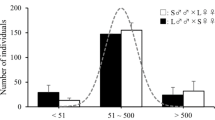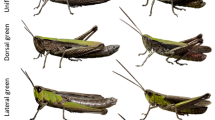Abstract
Estimates of the minimum number of genetic loci governing expressions of gregarious oviposition inMuscidifurax raptorellus Kogan & Legner were enabled by the verification of recombinant males, which were secured from virgin hybrid females, formed by crossing cohorts from solitary and gregarious populations. Examinations of parasitization behavior in female progeny that had F1 male fathers indicated the presence of hybrids among the males. Estimates of gene number, made on the basis of variances in P1, F1, F2 and backcross progeny, and by observing behavior in second and third order backcrosses, ranged from two to 19, with most between two and five. However, backcrossing data suggested that at least eight loci were actively segregating for this characteristic. Semi-dominance of the solitary trait (D=0.63 to 0.84), and unequal gene effects probably caused these gene estimated to be lower than the actual number. Estimates of the coefficient of heritability, in the broad sense based on parental and F1 and F2 variances indicated that variability of gregarious behavior in the experimental environment was influenced >60% by genotypic factors, offspring-parent regression analyses gave estimates >38%.
Résumé
L'analyse de mâles recombinants issus de femelles hybrides vierges, obtenues à partir de croisements effectués entre populations solitaires et grégaires deMuscidifurax raptorrelus Kogan & Legner, a permis d'estimer le nombre minimal de loci impliqués dans le déterminisme de la grégarité. L'étude de ce phénomène dans la descendance de femelles ayant pour père des mâles F1 indique la présence d'hybrides parmi ces mâles. Les estimations du nombre de gènes impliqués, obtenues à partir des variances calculées sur les générations P1, F1, F2 et sur celles issues des backcross de premier, deuxième et troisième ordre, sont toutes comprises entre deux et dix-neuf, la plupart entre deux et cinq. Les données de backcross suggèrent cependant qu'au moins huit loci segrègent activement dans le déterminisme de ce comportement. Des effets de semi-dominance (D=0.63 à 0.84) et des effets inégaux des gènes en cause expliquent probablement que les estimations obtenues conduisent à des résultats plus faibles que le nombre réel de loci impliqués. Des estimations du coefficient d'héritabilité, au sens large, fondées sur l'analyse de la variance des générations des parents, de la F1 et de la F2 indiquent que la variabilité de la grégarité est ici pour plus de 60% sous la dépendance de facteurs génotypiques. Des analyses par régression parents-enfants donnent des estimations supérieures à 38%.
Similar content being viewed by others
References
Berry, P. A. &Speicher, B. R. — 1972. Gene and chromosomal behavior in a parasitic wasp. —Am. Zool., 12, 3, 26.
Castle, W. E. — 1921. An improved method of estimating the number of genetic factors concerned in cases of blending inheritance. —Science, 54, 223.
Corbet, S. A. — 1985. Insect chemosensory responses: a chemical legacy hypothesis. —Ecol. Entomol., 10, 143–153.
Crozier, R. H. — 1971. Heterozygosity and sex determination in haplodiploidy. —Am. Nat., 105, 399–412.
Crozier, R. H. — 1975. Animal Cytogenetics 3, Insecta 7, Hymenoptera. —Berlin Gebruder Borntraeger, 95 pp.
Crozier, R. H. — 1977. Evolutionary genetics of the Hymenoptera. —Annu. Rev. Entomol., 22, 263–288.
Duncan, D. B. — 1955. Multiple range and multiple F tests. —Biometrics, 11, 1–41.
Falconer, D. S. — 1981. Introduction to Quantitative Genetics, 2nd ed. —Longman Publ. Co., London & New York, 340 pp.
Gardner, E. J. &Snustad, D. P. — 1984. Principles of Genetics, 7th ed. —John Wiley and Sons, N. Y., 648 p.
Goodenough, U. — 1984. Genetics, 3rd ed. —Saunders College Publ. Co., N. Y., 894 p.
Kawooya, J. K. — 1983. Electrophoretic discrimination of species of theMuscidifurax [Hymenoptera: Pteromalidae] complex. —Ph. D. Dissertation, Univ. of Illinois, Urbana, 113 pp.
Kogan, M. &Legner, E. F. — 1970. A biosystematic revision of the genusMuscidifurax [Hymenoptera: Pteromalidae] with descriptions of four new species. —Can. Entomol., 102, 1268–1290.
Lande, R. — 1981. The minimum number of genes contributing to quantitative variation between and within populations. —Genetics, 99, 541–553.
Legner, E. F. — 1987a. Inheritance of gregarious and solitary oviposition inMuscidifurax raptorellus Kogan and Legner [Hymenoptera: Pteromalidae]. —Can. Entomol., 119, 791–808.
Legner, E. F. — 1987b. Further insights into extranuclear influences on behavior elicited by males in the genusMuscidifurax [Hymenoptera: Pteromalidae]. —Proc. Calif. Mosq. & Vect. Contr. Assoc., 55, 127–130.
Legner, E. F. — 1988a.Muscidifurax raptorellus [Hymenoptera: Pteromalidae] females exhibit post mating oviposition behavior typical of the male genome. —Ann. Entomol. Soc. Am., 81, 524–527.
Legner, E. F. — 1988b. Quantitation of heterotic behavior in parasitic Hymenoptera. —Ann. Entomol. Soc. Am., 81, 657–681.
Legner, E. F. — 1988c. Hybridization in principal parasitoids of synanthropic Diptera: the genusMuscidifurax [Hymenoptera: Pteromalidae]. —Hilgardia, 56, 4, 36 pp.
Legner, E. F. — 1989a. Wary genes and accretive inheritance in Hymenoptera. —Ann. Entomol. Soc. Am., 82, 245–249.
Legner, E. F. — 1989b. Paternal influences in males ofMuscidifurax raptorellus [Hymenoptera: Pteromalidae]. —Entomophaga, 34, 307–320.
Legner, E. F. — 1989c. Phenotypic expressions of polygenes inMuscidifurax raptorellus [Hym.: Pteromalidae], a synanthropic fly parasitoid. —Entomophaga, 34, 37–44.
Metcalf, R. A., Marlin, J. C. &Whitt, G. S. — 1975. Low levels of genetic heterozygosity in Hymenoptera. —Nature, 257, 792–794.
Misra, R. K. — 1968. Statistical tests of hypothesis concerning the degree of dominance in monofactorial inheritance. —Biometrics, 24, 429–434.
Owen, R. E. — 1989. Differential size variation of male and female bumblebees. —J. of Heredity, 80, 39–43.
Raymond, M., Pasteur, N. &Georghiou, G. P. — 1986. Inheritance of chlorpyrifos resistance inCulex pipiens L. [Diptera: Culicidae] and estimation of the number of genes involved. —Heredity, 58, 351–356.
Sokal, R. R. &Rohlf, F. J. — 1981. Biometry, the Principles and Practice of Statistics in Biological Research. —W. H. Freeman & Co., San Francisco.
Steel, R. G. D. &Torrie, J. H. — 1980. Principles and Procedures of Statistics, 2nd Ed. —McGraw-Hill Book Co., Inc., New York.
Stone, B. F. — 1968. A formula for determining degree of dominance in cases of monofactorial inheritance of resistance to chemicals. —Bull. WHO, 38, 325–326.
Wright, S. — 1952. The genetics of quantitative variability. pp. 5–41 In:E. C. R. Reeve, andC. H. Waddington, eds. —Quantitative Inheritance. —Agric. Res. Council Her Majesty's Stationery Office, London, 151 pp.
Wright, S. — 1968. Evolution and the Genetics of Populations, Vol. I. —Genetic and Biometric Foundations. Univ. of Chicago Press, Chicago, 469 pp.
Author information
Authors and Affiliations
Rights and permissions
About this article
Cite this article
Legner, E.F. Estimations of number of active loci, dominance and heritability in polygenic inheritance of gregarious behavior inMuscidifurax raptorellus [Hymenoptera: Pteromalidae]. Entomophaga 36, 1–18 (1991). https://doi.org/10.1007/BF02374633
Received:
Accepted:
Issue Date:
DOI: https://doi.org/10.1007/BF02374633




